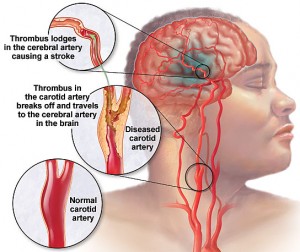Each year in the United States, 785,000 people suffer a stroke. Furthermore, it is the fourth leading cause of death and its consequences are among the top causes of disability in the U.S. The good news is that there are preventative measures you can take to reduce your risk of stroke, and most of them are simple lifestyle modifications.

- Control your diabetes. People with diabetes are at an increased risk for stroke especially when compared to those without diabetes; in fact the risk of cardiovascular disease as a whole is 2.5 times higher in people with diabetes than those without. Furthermore, according to the American Diabetes Association, 2 out of 3 people with diabetes die from a stroke or heart disease. Keeping your diabetes in check, either via medication, diet or weight loss, is the first step in reducing your risk of stroke.
- Quit smoking. Smokers have twice the risk for stroke compared to non-smokers because of the effects on the heart, blood and arteries; smoking reduces the amount of oxygen in the blood, resulting in the heart having to work harder and facilitating the formation of blood clots. Smoking also facilitates the buildup in the walls of the arteries, which may block blood flow to the brain, directly resulting in a stroke. Luckily, just by quitting smoking, you can greatly reduce your risk of stroke.
- Reduce your cholesterol levels. The amount of cholesterol and fat you consume directly correlates to the amount of plaque buildup in your arteries. This buildup, just like with smoking, can block normal blood flow to the brain, causing a stroke. High cholesterol can also increase your risk of heart disease and atherosclerosis, both of which are risk factors for stroke. Controlling your cholesterol through medications or diet will help reduce your risk of stroke.
- Control your hypertension (high blood pressure). Hypertension is known as the silent killer because some people who have it, never present with any symptoms. When untreated, it can lead to life-threatening conditions such as stroke, heart attack or kidney failure. Hypertension results in unnecessary stress on the walls of your blood vessels, causing them to thicken and deteriorate. Cholesterol or fats that have attributed to the thickening of vessel walls can break off, travel to another vessel and block blood flow to the brain. Again, keeping your high blood pressure in check with diet, exercise or medication, will help reduce your risk of stroke.
- Obesity. Obesity or even just being over-weight, puts additional and unnecessary strain on your entire circulatory system. Having either of these conditions also increases your risk for high cholesterol, high blood pressure and diabetes, all of which contribute to an increased risk of stroke. Maintain a healthy weight via diet and exercise to reduce your risk of stroke.
“A healthy lifestyle, including healthful eating, physical activity and regular doctors visits, can not only help you maintain overall well-being, but also help reduce your risk of stroke. If you have any of these modifiable risk factors, speak with your doctor immediately get them under control”, says Dr. Samadi, Chairman, Department of Urology and Chief of Robotics at Lenox Hill Hospital.
The acronym FAST will help you identify the signs of a stroke:
Face: ask the person to smile; does one half of the face droop?
Arms: ask the person to lift both arms; does one arm not lift as high?
Speech: ask the person to repeat a simple phrase; do they slur their speech?
Time: time is of the essence; if you observe any of these signs, call 911 immediately.



